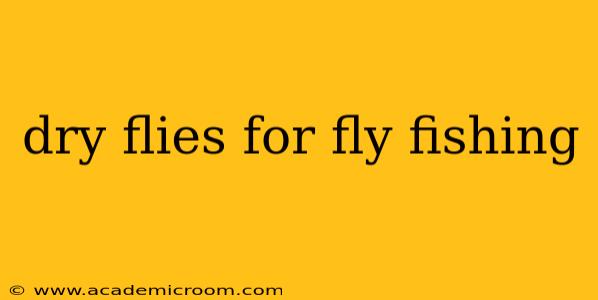Dry fly fishing, the art of presenting a fly that floats on the water's surface, is a captivating and rewarding angling technique. The subtle dance of a dry fly, mimicking a natural insect, can trigger explosive strikes from trout and other species. Understanding the nuances of dry flies – their patterns, materials, and applications – is key to success. This comprehensive guide delves into the world of dry flies, covering everything from choosing the right fly to mastering the presentation.
What are Dry Flies?
Dry flies are artificial flies designed to imitate terrestrial insects (like ants, beetles, and grasshoppers) or aquatic insects (like mayflies, caddisflies, and stoneflies) that have emerged from the water and are resting on the surface film. Unlike wet flies, which are fished submerged, dry flies float, allowing for a more natural and visually appealing presentation to the fish. Their buoyant nature is crucial; a sinking fly won't fool a trout expecting a floating insect.
What are the Different Types of Dry Flies?
The world of dry flies is vast, encompassing countless patterns designed to mimic specific insects in various stages of their life cycle. Some common types include:
-
Mayfly Dry Flies: These mimic the adult stage of mayflies, often featuring delicate hackles and wings to replicate the insect's natural movement on the water. Variations include the Adams, the Light Cahill, and the Parachute Adams.
-
Caddisfly Dry Flies: These flies imitate caddisflies, often with a more robust and fuzzy body to represent the insect's hairy structure. Popular patterns include the Elk Hair Caddis and the Stimulator.
-
Ant and Beetle Dry Flies: These terrestrial patterns are designed to represent ants, beetles, and other insects that fall onto the water's surface. They are often simpler in design, featuring a more compact and sturdy profile. Examples include the Ant and the Humpy.
How to Choose the Right Dry Fly?
Selecting the appropriate dry fly depends on several factors:
-
Matching the Hatch: Identifying the insects present on the water (the "hatch") is crucial. Observe the insects in the air and on the water to determine their species and life stage. Choose a fly that closely resembles the natural insects.
-
Water Conditions: The current speed, water clarity, and overall environment affect fly selection. In faster currents, a larger, more buoyant fly might be necessary, while in calmer waters, smaller, more delicate patterns might be more effective.
-
Time of Day: Insect activity varies throughout the day. Certain insects are more prevalent at dawn or dusk, influencing fly selection.
-
Fish Behavior: Observing the fish's feeding activity provides valuable insight. If fish are rising selectively, it suggests they are targeting a specific insect.
What Materials are Used to Make Dry Flies?
Dry fly construction involves a variety of materials, each contributing to the fly's buoyancy, appearance, and action. Common materials include:
-
Hooks: Specifically designed dry fly hooks with upward-pointing barbs to ensure the fly floats correctly.
-
Floats: Such as deer hair, elk hair, and foam, are essential for keeping the fly afloat.
-
WINGS: Made from feathers or synthetic materials, add to the fly's realistic appearance and movement.
-
HACKLES: Feathers used to create the body and wings, also provide important movement on the water's surface.
-
BODIES: Materials such as dubbing, yarn, and floss create the fly's body and enhance its resemblance to the insects being imitated.
How to Tie Dry Flies?
Tying dry flies requires skill and practice. Numerous online resources and books offer detailed instructions and tutorials for beginners. Start with simpler patterns before attempting more intricate designs. Proper tools, such as a vise, bobbin, and various tying materials, are essential.
What are Some Popular Dry Fly Patterns?
Many popular dry fly patterns have stood the test of time, proving their effectiveness across various water conditions and species of fish. A few well-known examples include the Adams, Royal Wulff, Elk Hair Caddis, Stimulator, and Parachute Adams. Each pattern possesses unique characteristics and is effective under different circumstances.
How Do You Fish Dry Flies?
The presentation of a dry fly is critical to success. A delicate, natural drift is essential to fool wary trout. Common techniques include:
-
Dead Drifting: Allowing the fly to drift naturally with the current.
-
Mending: Adjusting the fly line to maintain a straight drift.
-
Lifting and Dropping: Subtly lifting and dropping the fly to mimic a natural insect.
Why Do My Dry Flies Sink?
Several reasons can cause dry flies to sink:
-
Waterlogged materials: Over time, some fly materials may absorb water, reducing buoyancy.
-
Excessive weight: Heavy materials in the fly construction contribute to sinking.
-
Poor floatant application: Insufficient or improper application of floatant will diminish effectiveness.
How to Keep Dry Flies Afloat?
Maintaining buoyancy is essential for success with dry flies. Applying a high-quality fly floatant is crucial. This hydrophobic substance prevents water from clinging to the fly's surface. Reapply floatant as needed, especially in oily or polluted waters.
What Size Dry Flies Should I Use?
Fly size selection depends on the target species and the size of insects present. Observe the insects and experiment with different sizes to find what works best. Generally, smaller flies tend to be effective in clear water, while larger flies might be more effective in stained water or during periods of increased insect activity.
This guide provides a foundation for understanding and utilizing dry flies in your fly fishing adventures. Remember to practice your techniques, carefully observe the water, and most importantly, have fun!
